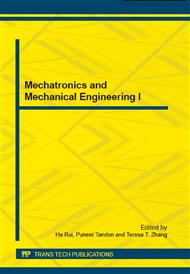p.3
p.8
p.14
p.18
p.23
p.28
p.34
p.38
The Influences of Interdigitated Electrode Asymmetry on the Actuation Performance of Piezoelectric Materials
Abstract:
The electrostatic field distribution of interdigitated electrode piezoceramics (IDEPZT) and piezoelectric fiber composite (IDEPFC) are analyzed by finite element method separately. The impact of the interdigitated electrode asymmetry on the actuation performance of piezoelectric actuators with a certain interlayer thickness is studied. The influence of the interdigitated electrode asymmetry on the actuation performance, stress concentration and electrostatic field concentration with different interlayer thicknesses are also discussed and compared. For piezoceramics, the results show that the actuation performance can be influenced little by increasing the degree of the excursion with a relatively thin interlayer thickness. As the interlayer thickness increases, the actuation performance can be influenced much by increasing the degree of the asymmetry. And it results in the decrease of the longitudinal free strain overall. The electric field becomes increasingly uneven as the degree of the asymmetry increases. The actuated stress can be improved evidently by increasing the degree of the asymmetry with a relatively thin interlayer thickness while the stress concentration is not increased apparently.
Info:
Periodical:
Pages:
18-22
Citation:
Online since:
October 2014
Authors:
Price:
Сopyright:
© 2014 Trans Tech Publications Ltd. All Rights Reserved
Share:
Citation:


